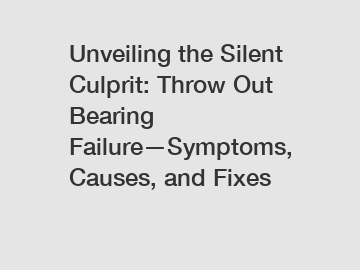Dec. 29, 2023
Mechanical Parts & Fabrication Services
AJRK Product Page
Unveiling the Silent Culprit: Throw Out Bearing Failure—Symptoms, Causes, and Fixes.
Throw out bearing failure, though not commonly discussed, is a notorious issue that plagues many manual transmission vehicles. This silent culprit often goes undetected until it is too late, leading to costly repairs and potentially leaving drivers stranded. In this article, we will look into the symptoms, causes, and fixes of throw out bearing failure, shedding light on this silent enemy.

Throw out bearings play a crucial role in the operation of a manual transmission system. Located inside the transmission bellhousing, these bearings enable the smooth engagement and disengagement of the clutch. When the clutch pedal is depressed, the throw out bearing applies pressure to the clutch diaphragm, releasing it from the clutch disc. Conversely, when the clutch pedal is released, the throw out bearing retracts, allowing the clutch to engage with the engine flywheel.
One common symptom of throw out bearing failure is a persistent noise when the clutch pedal is pressed. This noise, often described as a chirping or squealing sound, occurs due to excessive wear or damage to the bearing. Another symptom is difficulty in shifting gears, particularly when shifting into first or reverse. This problem arises from the lack of proper clutch engagement caused by a faulty or worn-out throw out bearing.
The primary cause of throw out bearing failure is prolonged or excessive clutch usage. Frequent heavy clutch usage, such as aggressive shifting or excessive clutch slipping, can accelerate wear on the bearing. Additionally, improper or insufficient lubrication of the throw out bearing can also lead to premature failure. It is essential to ensure that the bearing receives regular maintenance and lubrication to minimize the risk of failure.
To rectify throw out bearing failure, the most common solution is to replace the entire clutch assembly. This typically includes the clutch disc, pressure plate, and throw out bearing. It is crucial to address the issue promptly to prevent further damage to other components, such as the flywheel and the clutch forks. Furthermore, during the replacement process, it is advisable to inspect and replace any damaged or worn-out components associated with the clutch system.
The silent culprit, throw out bearing failure, may seem insignificant at first, but its consequences can be severe. Ignoring the symptoms or failing to address the issue promptly can result in extensive damage to the transmission system, leading to costly repairs and prolonged downtime. Understanding the causes and symptoms of throw out bearing failure empowers drivers to take proactive measures, ensuring the long-term health and performance of their vehicles.
In conclusion, throw out bearing failure may be a silent culprit, but its impact on a manual transmission system can be significant. By recognizing the symptoms, understanding the causes, and addressing the issue promptly, drivers can avoid costly repairs and keep their vehicles running smoothly. Regular maintenance, proper clutch usage, and timely replacement of worn-out components are key to preventing throw out bearing failure and ensuring optimal performance of manual transmission vehicles.
For more information, please visit our website.
Want more information on tensioner bearing function? Feel free to contact us.
If you are interested in sending in a Guest Blogger Submission,welcome to write for us!
All Comments ( 0 )